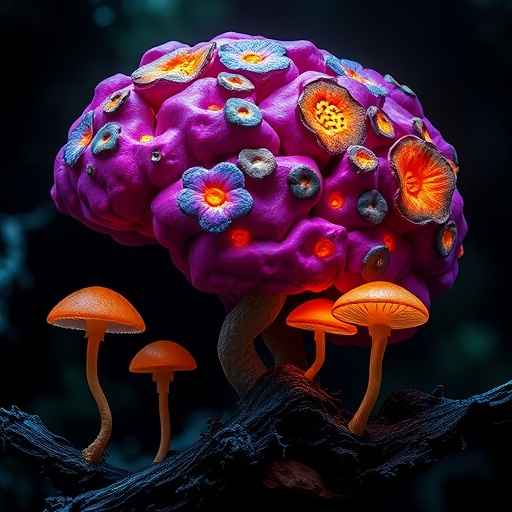
In recent years, there has been a surge of interest in the therapeutic potential of psychedelic compounds, specifically psilocybin, a naturally occurring psychedelic found in certain species of mushrooms. While its rapid and lasting antidepressant effects have been the focus of numerous clinical studies, the precise neural mechanisms by which psilocybin fosters behavioral flexibility have remained largely elusive. A groundbreaking new study published in Nature Neuroscience in 2025 sheds light on how psilocybin modulates neural ensemble dynamics in the retrosplenial cortex to enhance fear extinction, a process critical for overcoming maladaptive behaviors linked to anxiety and trauma-related disorders.
The ability to flexibly adjust behavior in response to changing environments is fundamental to adaptive function. Disorders characterized by extreme behavioral rigidity—such as post-traumatic stress disorder (PTSD), obsessive-compulsive disorder, and certain forms of depression—are notoriously difficult to treat using conventional therapies. Psilocybin has emerged as a promising agent for these conditions, producing rapid improvements thought to stem from heightened neural plasticity. However, prior investigations largely measured global brain activity or broad behavioral outcomes without pinpointing how specific neural circuits underpin sustained changes in behavioral flexibility.
To address this gap, researchers led by Rogers, Heller, and Corder devised a sophisticated experimental paradigm involving longitudinal single-cell calcium imaging within the mouse retrosplenial cortex (RSC). The RSC, interconnected with regions responsible for memory and spatial navigation, plays a pivotal role in integrating sensory and contextual information relevant to fear learning and extinction. This area’s contribution to behavioral flexibility made it an ideal target for high-resolution neural recordings during a five-day trace fear conditioning and extinction assay.
Their experimental setup was meticulously designed, combining precise timing of stimulus presentation with repeated imaging sessions that tracked individual neuronal ensembles over several days. Using genetically encoded calcium indicators, the team could visualize and measure activity fluctuations in hundreds of neurons simultaneously. This approach unveiled dynamic shifts within cortical microcircuits as animals learned to associate previously neutral cues with aversive stimuli and eventually unlearned these associations through extinction training.
One of the study’s most compelling findings was that a single dose of psilocybin induced marked alterations in the turnover of cortical ensembles. Specifically, the drug suppressed a subset of neurons active during fear expression (“fear-active” neurons) while recruiting a distinct population associated with extinction (“extinction-active” neurons). This bidirectional modulation correlated strongly with enhanced behavioral extinction, indicating that psilocybin promotes flexible updating of fear memories by reconfiguring the underlying neural architecture.
Importantly, the researchers demonstrated that the suppression of fear-active neurons was not merely a generalized dampening of cortical activity but rather a selective downregulation that allowed extinction-active ensembles to emerge and stabilize. This finely-tuned balance suggests a neural mechanism whereby psilocybin facilitates a shift from maladaptive fear states toward adaptive safety signaling, paving the way for persistent behavioral changes.
Complementing the in vivo imaging data, the team developed a computational model of the retrosplenial microcircuit that echoed their empirical findings. Within this model, inhibition of simulated fear-active units led to increased recruitment and firing of extinction-active units, which in turn elevated behavioral variability measured as fluctuations in freezing behavior. This synergy between experimental and theoretical approaches underscores the causal relevance of specific neural population dynamics to observed changes in fear responses.
These insights carry profound implications for the future of psychiatric treatments. By identifying the neural ensembles modulated by psilocybin during fear extinction, the study opens a window into targeted therapeutic interventions aimed at enhancing neural flexibility. This could inform strategies that combine pharmacological agents with behavioral therapies to optimize outcomes for patients suffering from entrenched anxiety and stress disorders.
Moreover, the use of longitudinal single-cell imaging represents a methodological leap. Capturing the evolution of individual neurons’ activity over days bridges the gap between transient pharmacological effects and lasting behavioral change, which has been a longstanding challenge in neuropsychiatric research. This work demonstrates how cutting-edge imaging techniques can unravel the complexity of neural circuit remodeling induced by psychedelics.
Additionally, the involvement of the retrosplenial cortex offers a novel perspective. Historically considered a region implicated primarily in spatial and contextual processing, this research highlights its critical role in fear-memory modulation and behavioral adaptation. Understanding how psilocybin orchestrates activity within this hub contributes to a more nuanced view of cortical contributions to emotional regulation.
The bidirectional modulation observed—simultaneous suppression of fear-active neurons alongside recruitment of extinction-active ones—reflects a sophisticated neural mechanism that likely underlies the rapid and durable therapeutic effects reported in clinical psilocybin studies. It challenges simplistic views of psychedelics as merely excitatory or disruptive agents, instead positioning them as enhancers of circuit-specific plasticity that promote adaptive rewiring.
Future avenues of research will undoubtedly build upon these findings by exploring whether similar mechanisms operate in other brain areas involved in emotional and cognitive flexibility, such as the prefrontal cortex and amygdala. Furthermore, extending these analyses to models of pathological fear or compulsive behavior could help determine the translational relevance to human psychiatric conditions.
Furthermore, the integration of computational modeling with physiological data paves the way for predictive frameworks that can simulate the effects of psychedelic compounds on neural network dynamics. Such models may eventually be refined to tailor individualized treatments based on a patient’s unique neurocircuitry, enhancing precision medicine efforts in psychiatry.
In summary, this pioneering study offers compelling evidence that psilocybin’s capacity to enhance behavioral flexibility arises from its ability to reshape retrosplenial cortical ensembles, selectively suppressing fear-related circuits while recruiting alternative neuronal populations engaged in extinction memory. This bidirectional modulation underpins the drug’s potent facilitation of fear extinction and provides a concrete biological substrate for its therapeutic efficacy.
As psychedelic research continues its rapid expansion, such mechanistic insights are invaluable for transforming these compounds from tools of experimental medicine into clinically effective, neurobiologically informed therapies. By elucidating how psilocybin promotes reorganization within specific cortical circuits, Rogers and colleagues have charted a course toward understanding and harnessing the neural basis of behavioral flexibility—a key to overcoming some of the most challenging neuropsychiatric disorders of our time.
Subject of Research:
The neural mechanisms by which psilocybin enhances behavioral flexibility, focusing on modulation of cortical neural ensembles during fear extinction in the retrosplenial cortex.
Article Title:
Psilocybin-enhanced fear extinction linked to bidirectional modulation of cortical ensembles.
Article References:
Rogers, S.A., Heller, E.A. & Corder, G. Psilocybin-enhanced fear extinction linked to bidirectional modulation of cortical ensembles. Nat Neurosci (2025). https://doi.org/10.1038/s41593-025-01964-9
Image Credits:
AI Generated
Tags: behavioral flexibility in trauma recoveryinnovative therapies for obsessive-compulsive disorderneural mechanisms of psilocybinovercoming PTSD with psilocybinpsilocybin and fear extinctionpsilocybin and maladaptive behaviorspsilocybin effects on neural plasticitypsilocybin research 2025psilocybin therapy for anxietypsychedelic compounds and mental healthretrosplenial cortex and behaviortreatment-resistant depression and psychedelics



